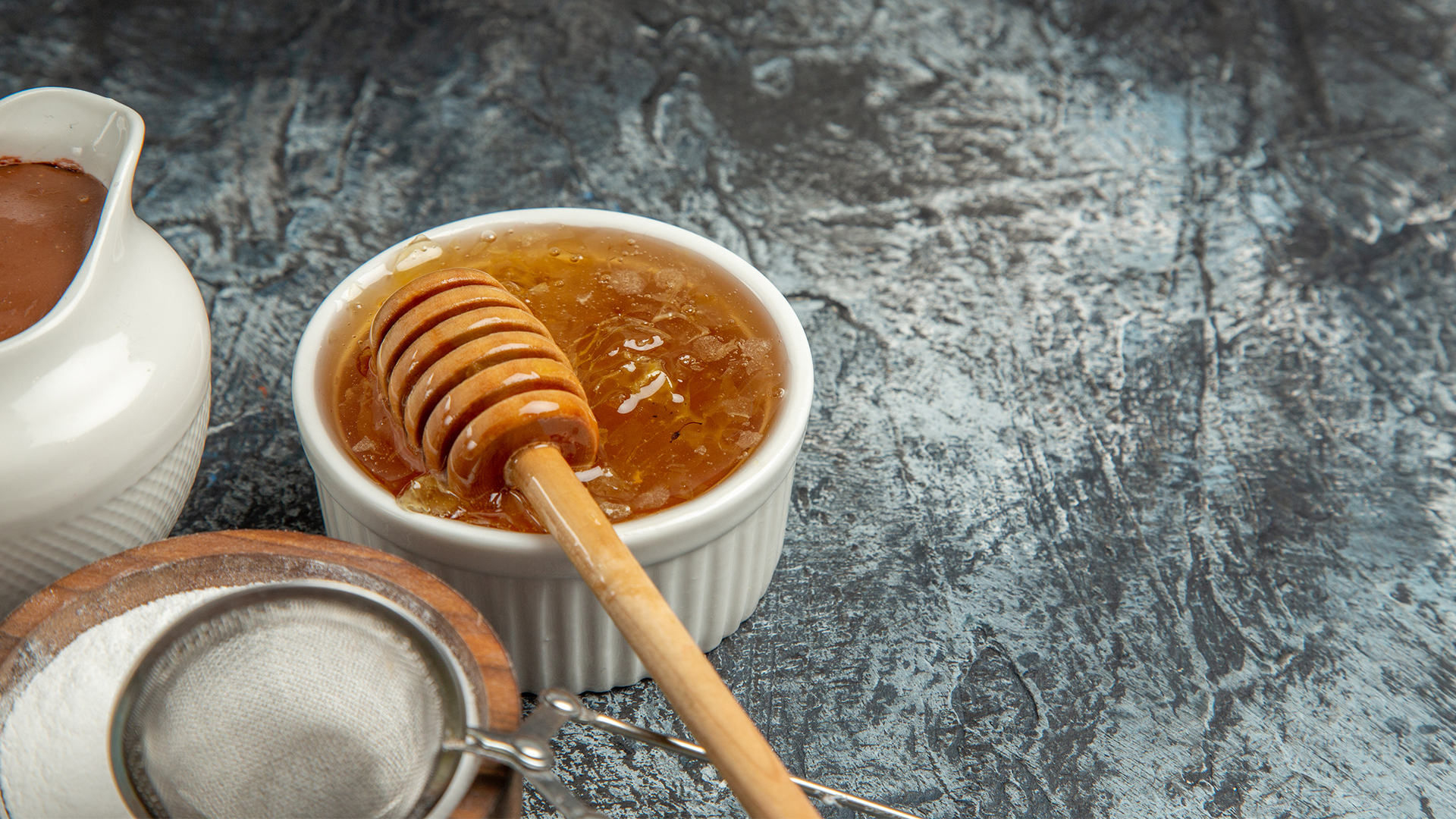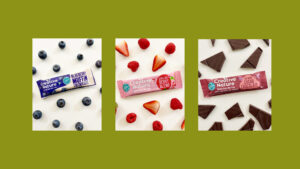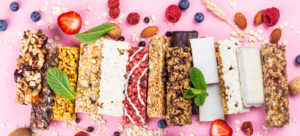Binder refers to “edible glue” used to wrap the snack bar’s dry ingredients and allow their aggregation. These binding agents are often mixed with softening agents and are dissolved in water to obtain a binding dispersion. Binding dispersion refers to the even distribution of a binding agent throughout a mixture. So, in the context of creating snack bars or similar products that involves ensuring that the binding ingredients are thoroughly distributed among the dry ingredients.
Essential Elements of a Binder
Forming a binder for snack bars involves combining ingredients that provide cohesion and structure to hold the bars together. You can use some sticky substances such as honey, maple syrup, mashed dates, or brown rice syrup that serve as a natural sticky binder. Fruit purees like mashed bananas, applesauce, or pureed fruits like figs or prunes contain natural sugars and pectin, aiding in binding.
You can use various ingredients to form that binding dispersion and generally more than one binder is used simultaneously. Ingredients such as syrups, sugars, fats, and polysaccharides can be used.
Utilizing Syrups and Sugars as Binders
Syrups and sugars are widely used as binders and sweeteners but also act as improvers of products during storage.
Role of Syrups and Sugars
Syrups and sugars are widely used as binders and sweeteners but also act as improvers of product stability during storage. Golden syrup and treacle are both utilized to stick oats and other dry ingredients together in flapjacks, resulting in a soft, chewy texture. Similarly, inverted sugar syrup or golden syrup is employed in large-scale production of granola and cereal bars, combining ingredients such as oats, nuts, and additives to create clusters while imparting a mild taste.
But sugar isn’t only used to combine the ingredients of sweet foods. One of the reasons sugar is effective in food preparation is its quality as a humectant enabling it to easily attract and retain water molecules. In other words, it is perfect for preserving moisture. This makes it a crucial element for manufacturers who are trying to maintain moisture in their products.
Desierable and Undesierable Effects
Manufacturers particularly favor inverted syrups because of their strong ability to hold onto water. Sugar, in its role as a stabilizer in food items, plays an important role in the creation of preserves, serving as a bulking agent. Some examples of syrups and sugars in their role as a binder are honey, corn syrup, rice syrup, dextrose syrup, sucrose, fructose, maltodextrin, etc. Their desirable effects are flavor, and chewy texture, enabling them to achieve the desired flexibility, and most importantly is that they hold the cereal components and dry ingredients together. Some undesirable effects are that sugar alcohols have reduced shelf life, undesirable texture, and dryness and they contribute to the caloric content of the product.
Exploring Polysaccharides in Binding
Polysaccharides are also used to form a binder for snack bars and are normally used in solution to increase the viscosity of the binding agent.
Polysaccharides and Their Role
Starch is most frequently inserted into binder formulation so that it achieves better thickening properties and stabilization. To be precise, starch is a carbohydrate polysaccharide which is a chain of sugar molecules that most green plants produce as a store of reserved energy. Cornstarch, the most commonly used cooking starch, forms a gel at approximately 95 degrees Celsius. When employed as a thickening agent in soups, sauces, or pie fillings, cornstarch tends to create lumps if added directly to hot liquid. For that reason, it is recommended to blend it into a slurry with room-temperature water before incorporating it into the recipe.
Application and Substitution in Binding Agents
Potato and arrowroot starch can be used in equal amounts as direct substitutes for cornstarch. Tapioca starch which is derived from the cassava root can also replace cornstarch, typically in a ratio of two parts tapioca to one part cornstarch. The difference is that when cooked cornstarch appears more opaque white, while tapioca results in a more translucent finish.
Textural Effects and Caloric Considerations
Tapioca starch is generally pricier than cornstarch, yet it has a chewy, gel-like consistency, especially in high concentrations. Algal polysaccharides can also be used as a thickener in snack bar formulation.
They belong to a family of linear sulfated polysaccharides that are extracted from red algae or red seaweed. Different polysaccharides provide different textural characteristics. Some good and desirable effects are that they are a good thickening agent and unlike sugar, it is desirable and also undesirable for polysaccharides to contribute to the caloric content of the product. Some other undesirable effects are hyperglycemic effects but less glycemic than simple sugar.
Understanding Fats as Binders
Fats are also considered good binding agents, those fats are from vegetal or animal origin and are mainly used as a carrier of flavor, or to shorten the binding dispersion. Butter is the most appreciated. It gives a better mouthfeel as compared to hydrogenated fat, yet butter is rich in saturated fats. However, due to its relatively high water content, butter might not be the ideal choice for creating a long-lasting, shelf-stable binder in your snack bars, as it can affect the bars’ stability and shelf life. Instead of butter, vegetable oils can also be used in making binders.
Choosing Suitable Oils and Butter Varieties
You can use oils that are derived from plants such as coconut oil, palm oil, or even olive oil. They contribute to the binding properties due to their fat content. In particular, coconut oil is solid at room temperature, which can help in binding the ingredients together when chilled. Furthermore, nut butter is used as a binding agent, and like peanut butter, almond butter, or cashew butter, nut butter also contains natural fats. These fats help bind the ingredients together while adding flavor and richness.
Similarly, seed-based butter like tahini (sesame seed butter) or sunflower seed butter contains fats that contribute to the binding properties of the mixture.
Balancing Melting Points and Shelf Stability
The thing that needs to be kept in mind when using fats as a part of the binder for snack bars is that it’s essential to consider the melting point of the fat at room temperature.
Fats that are solid at room temperature can help maintain the shape and structure of the bars once they’ve solidified. Just like sugars and syrups, the undesirable effects of fats are that they contribute to the caloric content of the product. Also what is bad about using fats as a binder is that they oxidize during storage and have an undesirable mouthfeel. However, the desirable effects are that they avoid sugar crystallization and weaken the binder.
So to conclude, for creating the binder choose one or a combination of these ingredients based on taste preferences and dietary requirements. Combine the selected ingredients in a bowl or food processor until they form a cohesive, sticky paste or liquid. Then you will need to ensure that the mixture has a sticky texture that will hold the other ingredients together.
What needs to be considered is that fats, like coconut oil or nut/seed kinds of butter, help in binding and can add richness and flavor. Also, you can experiment with proportions and combinations to achieve the desired texture and taste. Once the mixture is prepared and combined with other ingredients, press it firmly into a lined baking dish or pan and then refrigerate or bake, according to the recipe instructions to set the bars.
Creating a binder is a crucial step in making snack bars, as it holds the ingredients together and contributes to the overall taste and texture.
Leading image: Image by Freepik





